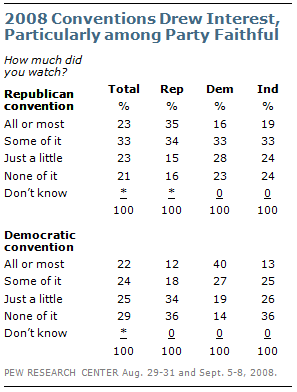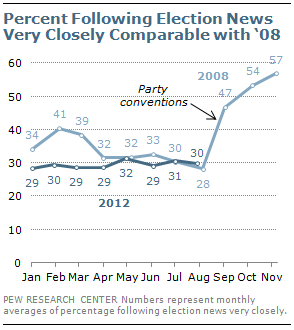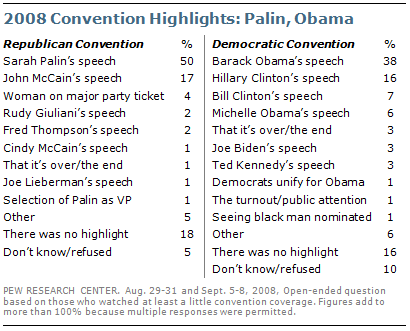
Despite limited primetime coverage, the Republican and Democratic conventions still give the parties a chance to define their presidential candidates and spark public interest in the campaign.
In 2008, notably, both conventions attracted sizable audiences, especially among their own partisans.
In a Pew Research Center survey conducted after the Republican convention in St. Paul, Minn., 56% of Americans said they watched at least some of the convention. A week earlier, somewhat fewer (46%) said they watched at least some of the Democratic convention in Denver.
Following the back-to-back conventions four years ago, public interest in the campaign surged. The week before the Democratic convention in 2008, 31% said they were following news about the campaign very closely. That jumped to 45% the week of the Democratic convention and stayed at that level as Republicans gathered the next week.
Not surprisingly, conventions primarily attract interest among the party bases. Four years ago, 69% of Republicans watched at least some of their party’s convention; 35% said they watched all or most of it. Similarly, 67% of Democrats watched at least some of their party’s convention; 40% watched all or most of it.
The GOP convention attracted more cross-party interest than did the Democratic convention. Nearly half of Democrats (49%) said they watched at least some of the GOP convention; just 30% of Republicans tuned into at least some of the Democratic convention.
Conventions Spark Interest in Presidential Campaign
If history is a guide, public interest in the presidential campaign is likely to increase substantially after the Republican convention in

Tampa next week and the Democratic convention in Charlotte the following week.
Through much of this election cycle – especially in recent months – interest in campaign news has been comparable to interest in the 2008 race. Four years ago, the percentage following presidential election news very closely dipped following the early primary fights between Barack Obama and Hillary Clinton but then ramped up sharply at the end of the summer as the parties met to nominate their candidates. Interest continued to rise until Election Day.
Similarly in 2004, interest in campaign news increased following the conventions. That year, the Democratic convention was held at the end of July and the GOP convention spanned the end of August and the start of September. In July, 29% said they were following news about the presidential campaign very closely. That increased to 40% in September, following the conventions that nominated George W. Bush and John Kerry.
Later this fall, the presidential debates also are likely to attract strong interest. In October 2008, 73% said they had watched at least some of the presidential debate coverage: 41% said they watched all of the debate coverage and 32% said they watched some. Only 20% said they didn’t watch any coverage of the three televised debates.
Conventions Showcase Candidates
With the agenda controlled by the parties, the conventions provide a chance to put the best face on each ticket. In addition to appealing to the undecided, both parties are eager to build enthusiasm within their bases.
For Republicans, that means boosting Romney’s personal image among the public as a whole and even among Republicans, where his favorability levels are well below those for Bush in 2004 and John McCain in 2008. (See: “Romney’s Personal Image Remains Negative”). Democrats, meanwhile, will be working to boost the enthusiasm of the young and minority voters so important to Obama’s win four years ago. (See: “GOP Holds Early Turnout Edge, But Little Enthusiasm for Romney”.)
The conventions can offer memorable and defining moments. In 2008, 38% of those who had watched at least some coverage of the Democratic convention said that Obama’s speech had been the highlight of that convention for them. No other moment came close: 16% cited Hillary Clinton’s speech, 7% Bill Clinton’s and 6% Michelle Obama’s.
On the GOP side, the arrival of Sarah Palin on the national political scene as McCain’s vice presidential nominee proved the top moment for many and overshadowed John McCain’s own convention speech; 50% cited Palin’s speech as the highlight of the convention for them, while just 17% said the highlight was McCain’s speech.

A Convention Bounce?
Traditionally, presidential candidates see jumps in support following their conventions, though those bounces have often been short-lived. Polls conducted immediately after the GOP convention four years ago showed that McCain was running better against Obama than he had all year. (For more on the history of post-convention bounces, see “The Bounce Effect,” Sept. 11, 2008.)
But Pew Research’s first post-convention survey, conducted about week later, showed no gain for McCain. The race was deadlocked, as it had been a month earlier.
In 2004, George W. Bush broke open a deadlocked contest immediately after his party’s convention, but his lead quickly narrowed. In a survey conducted prior to that year’s Republican convention, 47% of registered voters said they planned to vote for Kerry and 45% said they planned to vote for Bush. Just after the Republican gathering, Bush had a 52% to 40% edge. Days later, however, Bush and Kerry were again running even.